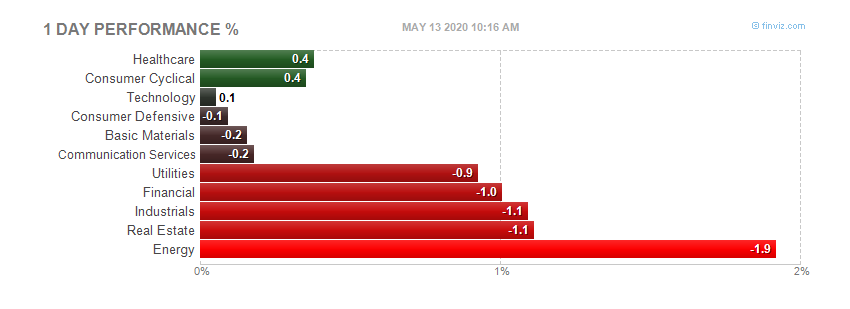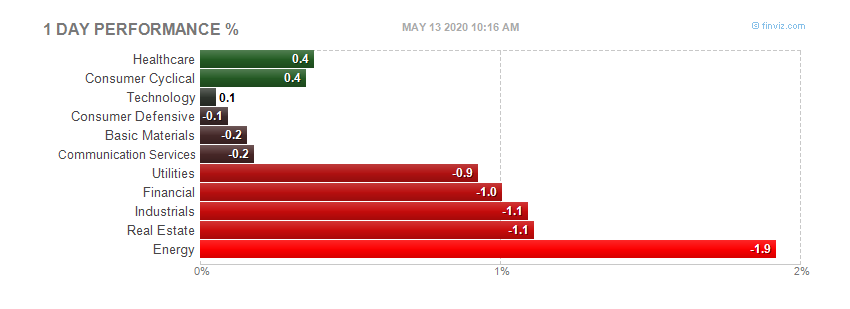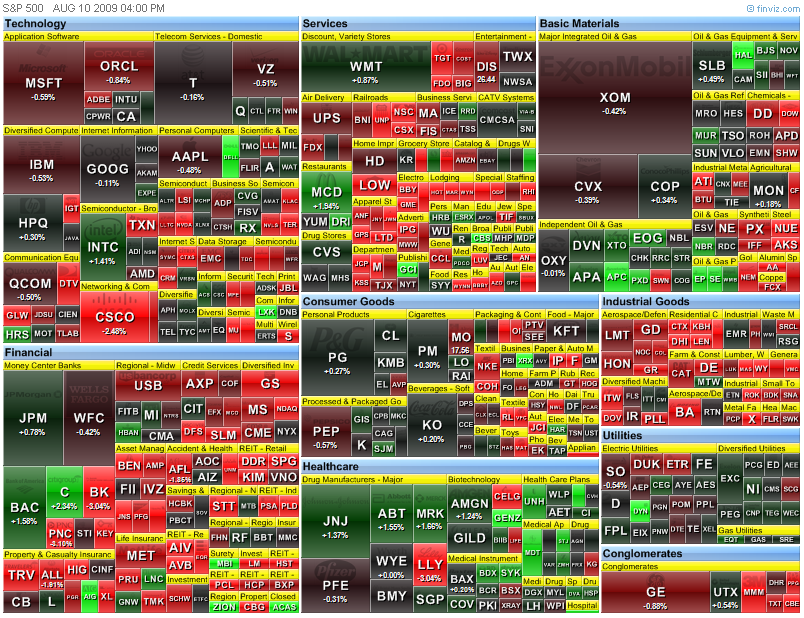 Today's heatmap:
Today's heatmap:

Daily information of the stock market.
 Today's heatmap:
Today's heatmap:

 The food and beverages index, which rose 0.1 percent in June, fell 0.2 percent in July. The decrease was caused by the food at home index, which declined for the seventh time in the last eight months, falling 0.5 percent. All six major grocery store food group indexes fell, with the largest decreases being a 1.3 percent decline in the index for meats, poultry, fish and eggs and a 0.6 percent decline in the dairy and related products index, which has now fallen for eight months in a row.
The cereals and bakery products index posted the smallest decrease of the six groups, falling 0.1 percent. The indexes for fruits and vegetables, for nonalcoholic
beverages, and for other food at home all declined 0.3 percent in July. The food at home index has declined 2.6 percent from its peak in November 2008. In contrast to the decline in the food at home index, the food away from home index rose 0.1 percent in July and the index for alcoholic beverages increased 0.3 percent.
The housing index fell 0.2 percent in July after being unchanged in June. The index for shelter fell 0.2 percent and the household energy index declined 0.3 percent. Within the shelter group, the indexes for rent and owners’ equivalent rent were both unchanged in July after rising 0.1 percent in June. The index for lodging away from home turned down in July, falling 2.1 percent after increasing 0.3 percent in June, and has fallen 8.9 percent over the past 12 months. Within household energy, a 0.9 percent increase in the index for natural gas was more than offset by declines in the other indexes, including a 0.6 percent decrease in the electricity index and a 1.5 percent fall in the fuel oil index.
The index for household furnishings and operations, unchanged for each of the previous three months, declined 0.1 percent in July. For the past 12 months, the housing index has declined 0.7 percent, with the shelter index up 0.9 percent and the household energy index down 14.1 percent.
After rising 4.2 percent in June, the transportation index increased 0.2 percent in July. Most of the moderation was due to the motor fuel index, which fell 0.4 percent in July after rising 17.2 percent in June. The new vehicle index increased 0.5 percent in July after rising 0.7 percent in June, and the index for used cars and
trucks was unchanged in July after rising 0.9 percent in June.
The public transportation index, however, turned up in July, rising 1.9 percent after declining 0.5 percent in June. The turnaround was mostly due to the index for airline fares, which rose 2.1 percent in July after declining in each of the previous ten months. Over the past 12 months, the transportation index has fallen 14.1 percent, with several of its components declining. The gasoline index fell 37.3 percent while the index for airline fares declined 16.6 percent and the index for used cars and trucks decreased 7.9 percent. However, the new vehicle index has risen 1.2 percent over the past 12 months.
Among other CPI groups, the medical care index rose 0.2 percent in July, the same increase as in June. Within that group, the index for hospital and related services rose 0.7 percent while the index for prescription drugs was unchanged. Over the last 12 months, the medical care index has risen 3.2 percent.
The index for other goods and services rose 0.8 percent in July after advancing 0.3 percent in June. The larger increase was driven by the tobacco index, which rose 2.2 percent as excise tax increases in several states went into effect in July. The tobacco index has now risen 27.8 percent over the past year.
The apparel index advanced 0.6 percent in July after a 0.7 percent increase in June. The index for education and communication rose 0.3 percent in July after rising 0.2 percent in June, while the index for recreation was unchanged in July after rising 0.5 percent in June.
More charts and info at link.
The food and beverages index, which rose 0.1 percent in June, fell 0.2 percent in July. The decrease was caused by the food at home index, which declined for the seventh time in the last eight months, falling 0.5 percent. All six major grocery store food group indexes fell, with the largest decreases being a 1.3 percent decline in the index for meats, poultry, fish and eggs and a 0.6 percent decline in the dairy and related products index, which has now fallen for eight months in a row.
The cereals and bakery products index posted the smallest decrease of the six groups, falling 0.1 percent. The indexes for fruits and vegetables, for nonalcoholic
beverages, and for other food at home all declined 0.3 percent in July. The food at home index has declined 2.6 percent from its peak in November 2008. In contrast to the decline in the food at home index, the food away from home index rose 0.1 percent in July and the index for alcoholic beverages increased 0.3 percent.
The housing index fell 0.2 percent in July after being unchanged in June. The index for shelter fell 0.2 percent and the household energy index declined 0.3 percent. Within the shelter group, the indexes for rent and owners’ equivalent rent were both unchanged in July after rising 0.1 percent in June. The index for lodging away from home turned down in July, falling 2.1 percent after increasing 0.3 percent in June, and has fallen 8.9 percent over the past 12 months. Within household energy, a 0.9 percent increase in the index for natural gas was more than offset by declines in the other indexes, including a 0.6 percent decrease in the electricity index and a 1.5 percent fall in the fuel oil index.
The index for household furnishings and operations, unchanged for each of the previous three months, declined 0.1 percent in July. For the past 12 months, the housing index has declined 0.7 percent, with the shelter index up 0.9 percent and the household energy index down 14.1 percent.
After rising 4.2 percent in June, the transportation index increased 0.2 percent in July. Most of the moderation was due to the motor fuel index, which fell 0.4 percent in July after rising 17.2 percent in June. The new vehicle index increased 0.5 percent in July after rising 0.7 percent in June, and the index for used cars and
trucks was unchanged in July after rising 0.9 percent in June.
The public transportation index, however, turned up in July, rising 1.9 percent after declining 0.5 percent in June. The turnaround was mostly due to the index for airline fares, which rose 2.1 percent in July after declining in each of the previous ten months. Over the past 12 months, the transportation index has fallen 14.1 percent, with several of its components declining. The gasoline index fell 37.3 percent while the index for airline fares declined 16.6 percent and the index for used cars and trucks decreased 7.9 percent. However, the new vehicle index has risen 1.2 percent over the past 12 months.
Among other CPI groups, the medical care index rose 0.2 percent in July, the same increase as in June. Within that group, the index for hospital and related services rose 0.7 percent while the index for prescription drugs was unchanged. Over the last 12 months, the medical care index has risen 3.2 percent.
The index for other goods and services rose 0.8 percent in July after advancing 0.3 percent in June. The larger increase was driven by the tobacco index, which rose 2.2 percent as excise tax increases in several states went into effect in July. The tobacco index has now risen 27.8 percent over the past year.
The apparel index advanced 0.6 percent in July after a 0.7 percent increase in June. The index for education and communication rose 0.3 percent in July after rising 0.2 percent in June, while the index for recreation was unchanged in July after rising 0.5 percent in June.
More charts and info at link.
 After close
After close

 The banks win again, not a surprise at all.
Today's heatmap:
The banks win again, not a surprise at all.
Today's heatmap:


 Full report here
The Manufacturing and Trade Inventories and Sales Report for July is scheduled to be released September 15, 2009 at 10:00 a.m. EDT.
For information, visit the Census Bureau’s Web site at
Full report here
The Manufacturing and Trade Inventories and Sales Report for July is scheduled to be released September 15, 2009 at 10:00 a.m. EDT.
For information, visit the Census Bureau’s Web site at  See footnotes and notes at the end of Table 3.
(p) Preliminary estimate.
(r) Revised estimate.
See footnotes and notes at the end of Table 3.
(p) Preliminary estimate.
(r) Revised estimate.

 (p) Preliminary estimate.
(r) Revised estimate.
1 Inventories are on a non-LIFO basis as of the end of the month.
2 Adjusted for seasonal variations and, in the case of sales, for trading-day differences and holiday variations. Concurrent seasonal adjustment is being used to adjust all sales, shipment, and inventory estimates. Concurrent seasonal adjustment uses all available unadjusted estimates as input to the X-12-ARIMA program. The factors derived from the program are applied to the current and previous month estimates and for retail and wholesale estimates a year ago as well. For retail sales, concurrent seasonal adjustment is also used to adjust the advance estimates (published one month before the preliminary estimates) and the estimates one year before the advance month. This explains the revision to retail estimates from a year ago.
3 Manufacturers sales refer to the value of shipments by manufacturers. The shipments data from individual manufacturers are adjusted prior to tabulation for the number of trading days as well as for any variations in the length of the reporting period.
4 The 2002 North American Industry Classification System (NAICS) defines merchant wholesalers as including manufacturers' sales branches and offices. However, the estimates included in this release exclude manufacturers' sales branches and offices. Note that this is not a change in coverage from prior releases and is consistent with the description used in the Monthly Wholesale Trade Survey data products.
Note: U.S. and group totals include kinds of business not shown. The Manufacturing and Trade Inventory and Sales estimates are based on data from three surveys: the Monthly Retail Trade Survey, the Monthly Wholesale Trade Survey, and the Manufacturers’ Shipments, Inventories, and Orders Survey. The sampling variability for retailers and merchant wholesalers can be used to construct a 90 percent confidence interval for the estimates. Over all possible samples, 90 percent of such intervals will cover the true estimate. These intervals are given in parentheses for the estimates on the front page. If, for example, the estimate is up 0.8 percent and the margin of sampling error is ±1.2 percent, the 90 percent confidence interval is -0.4 percent to +2.0 percent. If the range contains 0, it is uncertain whether there was an increase or decrease. Measures of reliability for Retail and Wholesale sales and inventory levels and changes are included in the detailed monthly press releases for those Industries. Manufacturers do not contribute to estimates of sampling variability because the manufacturer’s mail panel is not a probability sample from a known frame and standard errors of the industry estimates cannot be calculated. Estimates from all three surveys are also subject to nonsampling errors, which can arise in any stage of the survey. Such errors include coverage error (failure to accurately represent all population units in the sample), response errors, coding errors, and nonresponse. Although no direct measurement of these errors has been obtained, precautionary steps were taken in all phases of the collection, processing, and tabulation of the data to minimize their influence.
(p) Preliminary estimate.
(r) Revised estimate.
1 Inventories are on a non-LIFO basis as of the end of the month.
2 Adjusted for seasonal variations and, in the case of sales, for trading-day differences and holiday variations. Concurrent seasonal adjustment is being used to adjust all sales, shipment, and inventory estimates. Concurrent seasonal adjustment uses all available unadjusted estimates as input to the X-12-ARIMA program. The factors derived from the program are applied to the current and previous month estimates and for retail and wholesale estimates a year ago as well. For retail sales, concurrent seasonal adjustment is also used to adjust the advance estimates (published one month before the preliminary estimates) and the estimates one year before the advance month. This explains the revision to retail estimates from a year ago.
3 Manufacturers sales refer to the value of shipments by manufacturers. The shipments data from individual manufacturers are adjusted prior to tabulation for the number of trading days as well as for any variations in the length of the reporting period.
4 The 2002 North American Industry Classification System (NAICS) defines merchant wholesalers as including manufacturers' sales branches and offices. However, the estimates included in this release exclude manufacturers' sales branches and offices. Note that this is not a change in coverage from prior releases and is consistent with the description used in the Monthly Wholesale Trade Survey data products.
Note: U.S. and group totals include kinds of business not shown. The Manufacturing and Trade Inventory and Sales estimates are based on data from three surveys: the Monthly Retail Trade Survey, the Monthly Wholesale Trade Survey, and the Manufacturers’ Shipments, Inventories, and Orders Survey. The sampling variability for retailers and merchant wholesalers can be used to construct a 90 percent confidence interval for the estimates. Over all possible samples, 90 percent of such intervals will cover the true estimate. These intervals are given in parentheses for the estimates on the front page. If, for example, the estimate is up 0.8 percent and the margin of sampling error is ±1.2 percent, the 90 percent confidence interval is -0.4 percent to +2.0 percent. If the range contains 0, it is uncertain whether there was an increase or decrease. Measures of reliability for Retail and Wholesale sales and inventory levels and changes are included in the detailed monthly press releases for those Industries. Manufacturers do not contribute to estimates of sampling variability because the manufacturer’s mail panel is not a probability sample from a known frame and standard errors of the industry estimates cannot be calculated. Estimates from all three surveys are also subject to nonsampling errors, which can arise in any stage of the survey. Such errors include coverage error (failure to accurately represent all population units in the sample), response errors, coding errors, and nonresponse. Although no direct measurement of these errors has been obtained, precautionary steps were taken in all phases of the collection, processing, and tabulation of the data to minimize their influence.
 More at link
More at link

 More at link
More at link
 Before market opens
Before market opens
 Today after
Today after
 Today's heatmap:
Today's heatmap:

 Today before open
Today before open
 Today after close
Today after close
 Today's heatmap:
Today's heatmap:
